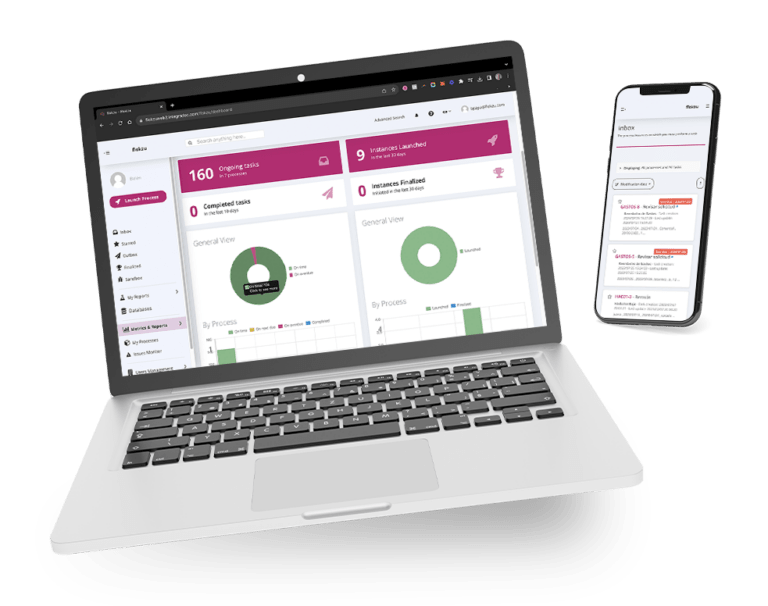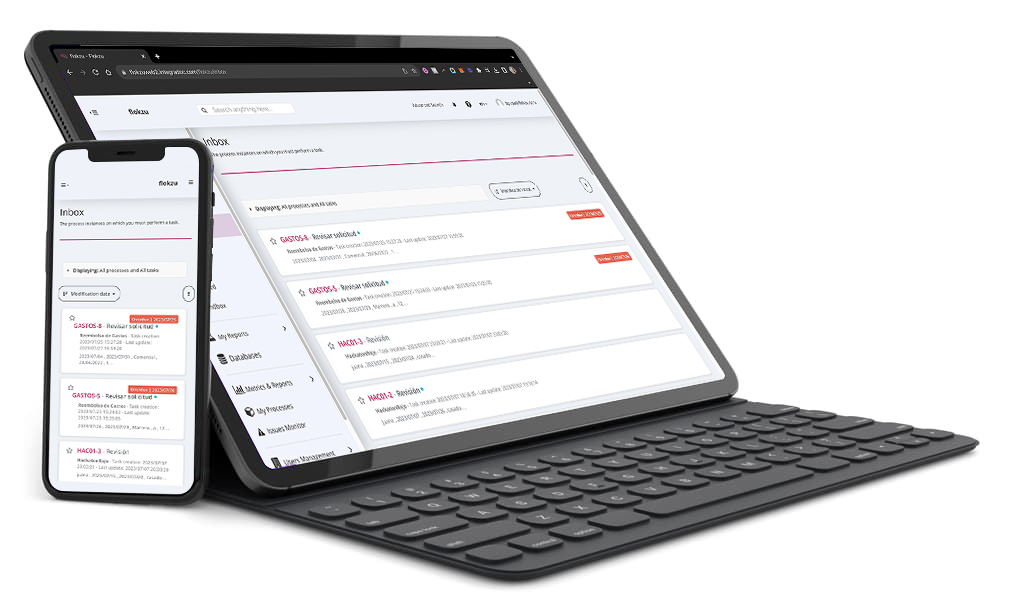
Cloud BPM
A cloud BPM software is a platform that allows automating and optimizing real processes in a cloud-based program.

What is a Cloud BPM Suite?
By having a fully automated process in Flokzu, the process engine (BPMN Engine) is responsible for interpreting the processes definition in BPMN notation, evaluating the conditions, assigning the tasks to the participants (human or other systems), integrating with other systems, issuing reports and sending them periodically, etc.
In particular, Flokzu Cloud BPM, allows to model each business process graphically, execute it and have the participants complete the tasks, and finally automatically generate real-time and historical performance indicators to analyze how the process is working.
Considering that all this is done in an agile way, without coding or complex configurations, Flokzu is considered one of the most relevant products in the low-code / no-code BPM category.
By having a fully automated process in Flokzu, the process engine (BPMN Engine) is responsible for interpreting the processes definition in BPMN notation, evaluating the conditions, assigning the tasks to the participants (human or other systems), integrating with other systems, issuing reports and sending them periodically, etc.
What problem does a Cloud BPM suite solve?
Processes are the muscles of the organization, they allow to carry out those activities necessary to achieve each of the objectives. There are productive processes (those that are vital to deliver the organization's product or service) or support processes (secondary and necessary for the productive processes). When these processes are not optimized, the organization loses competitiveness, serves its customers less satisfactorily, does not grow and even puts its survival at risk.
The discipline of business process management (BPM) proposes a cycle of continuous improvement of processes, through their formalization, automation and execution in a software called BPM Suite. The following problems are solved:
-
Endless chains of e-mails, spreadsheets and messages.
Automating processes in a centralized cloud BPM software tool reduces or eliminates the need for back-and-forth emails, WhatsApp messages, and logging in endless spreadsheets. Instead, everyone works on the same platform, eliminating information silos and tasks that get forgotten or delayed.
-
Searches or requests for information that take hours and wear out.
Organizational knowledge management reduces the time spent searching for information or asking other people for it. All relevant information to complete a task (data, attachments, comments from other people), travels in the process and is delivered to each person, at the moment they need it to complete their tasks.
-
Informality or lack of knowledge of how the processes work.
Having a graphical and formal definition of the processes (in BPMN notation) allows its review and discussion by the people involved. This allows them to identify improvements, eliminate unnecessary tasks or steps, balance the work, perform simultaneous tasks, etc.
-
Costs and errors when passing information manually from one system to another.
The solution is to integrate the processes with other information systems, either internal to the organization (using Web Services and the public API)) or in the cloud (using the Zapier connector).
-
Lack of visibility on process execution.
Measuring in real time and historically, using , key performance indicators (KPI’s) allows you to make decisions based on objective data and not subjective perceptions to improve processes.
More about BPM


From Kanban to BPM: A Detailed Analysis of Flokzu and Alternative Products

Significant Steps in the Progression of Process Modeling

Modeling Techniques: From Traditional to Modern

Case Study: Digital Transformation Through Process Modeling

Examining the Influence of Technology on Contemporary Modeling

Current Challenges in Business Process Modeling

Emerging Trends in Process Modeling and Design

Modeling’s Importance in the Process of Continuous Improvement
What benefits will I obtain?
It would be impossible to list all the benefits of formalizing and automating the organization's business processes. However, based on more than 17000 organizations subscribed to Flokzu, we see that the most repeated benefits are:
Improve results (cost reduction, higher production).
Natural consequence of the automation of repetitive tasks and higher productivity of people.
Greater satisfaction and retention of talent.
by having modern and collaborative tools for their daily work and not wasting time on manual tasks of little added value.
Better integration of the value chain.
Inserting from suppliers to customers in a single digital process allows a more fluid and efficient communication, ensuring compliance with SLAs with each of them.
Visibility and Compliance.
Processes are taken out of "people's heads", centralized and ensured to always execute as designed. This also allows immediate impact of any change (whether due to new regulations, market changes, internal restructuring, etc.).
Robustness and scalability.
By having formalized and automated processes, fewer failures and unforeseen events occur, while production can be increased more easily without a proportional increase in costs.
Modernization and market access.
The total digitization of operations enables modern and efficient internal and customer-facing management, which is key to capturing new markets.
Remote and asynchronous work.
It is no longer enough to work remotely; working asynchronously requires information to be centralized and available at any time so that people can complete their tasks. This makes it possible to count on the best talent, no matter where they are in the world.
Autonomy.
Model your processes as your company may need and adapt them as you want. With low-code / no-code technology, you will be able to automate any process without IT knowledge or external consultants.
Collaborative workspace.
Set up teams to work on one process at a time, or manage your processes by business departments. This tool allows you to work collaboratively, remotely, and in an asynchronous way, but ensuring results.
Can I automate long and complex processes?
In real organizations, processes can often be very complex (dozens, even hundreds of steps), involving many people and roles, and can take up to months. Think for example of a design and launch process of a new product in a manufacturing company, involving engineering, marketing, sales, finance, customer service, etc.
Indeed, in real and complex processes is where the greatest benefits of automation are obtained. Automation and collaboration are crucial in complex processes of real organizations. Imagine a process of designing and launching a new product that involves multiple areas and roles in a manufacturing company. Automation ensures assigned tasks, controlled deadlines, and efficient monitoring. Moreover, it provides performance indicators and allows instant changes without affecting production.
Discover how a BPM Suite in the cloud optimizes these complex processes in the following article.
And most importantly, changes in the process can be implemented immediately (without programming), generating a new version of the process. This version is tested in the version of the process., without putting at risk the processes of the productive environment. And if everything works well, deploy it in production with a single click.
In this article, the application of a Cloud BPM Suite in real organizations with complex processes is illustrated in more detail.,
How do users participate in the process?
In the most basic operation, the user accesses a process instance that was assigned to him, and will have different buttons to make the corresponding decisions in this task. These decisions were defined when modeling the process. Generally, each of these decisions will take the process down a different path. Flokzu also allows to use first order logic to evaluate the conditions (for example: “Authorized X Amount < 1000").
This operation is very important, because it hides the complexity of the business logic from the user. Thus, each user only has to worry about correctly completing his task, and it is the process engine that is in charge of evaluating all the conditions and defining the next steps. As a corollary, it is much easier to change business rules and ensure immediate compliance.
Helping companies across the world




























What is the future of these technologies?
The technology consulting firm Gartner predicted in this article (April 2021) that the global market for hyper-automation-enabling technologies will reach $600 billion by 2022. The fundamental pillar of these technologies is Business Process Management and Automation, on which others such as artificial intelligence are mounted.
It also mentions that hyper-automation enables organizations to quickly identify, examine and automate as many processes as possible through the use of technologies such as cloud BPM suites, low-code platforms, repetitive task automation (RPA), artificial intelligence (AI) and virtual assistants.
In the medium term, Gartner expects a 30% reduction in operating costs, combining hyper-automation technologies with process redesign.
In this path of total digitization and hyper-automation of processes, tools that are both user-friendly and powerful enough to support real processes, such as Flokzu, become fundamental pillars on which build the entire digital strategy of each organization.



























